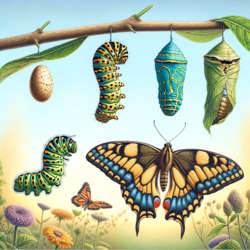Metamorphosis (biology)
|
|

![Butterfly image provided by [http://classroomclipart.com Classroom Clipart]](/encyclopedia/images/thumb/d/d9/250px-Butterfly.jpg)
It usually accompanies a change of habitat or of habits but may occur without such change. It was once thought that in those cases where the animal's habitat remains unchanged metamorphosis followed a series of forms representing evolutionary ancestors of the species in question (see ontogeny recapitulates phylogeny), but this is no longer thought to be the case.
The first type of metamorphosis is illustrated by many insects and by amphibians. Immature dragonflies are aquatic though the adults are flying insects, and frogs undergo a metamorphosis from an aquatic tadpole to an amphibious adult form. Change of habits is illustrated by the transformation of the free-swimming young of many aquatic invertebrates into sessile adults (eg sea squirts), and the development of butterflies and moths from caterpillars with chewing mouthparts into flying insects with sucking mouthparts.The second type is illustrated by many crustacean species, whose young undergo significant physical metamorphosis without changing habits or habitat significantly.
The immature stages of a species that undergoes metamorphosis are designated by the term larva. In the complex metamorphosis of many insect species, however, only the first stage is called a larva and sometimes even that bears a different name; the distinction depends upon the nature of the metamorphosis.Some insects hatch from the egg already having the general form of the adult, and the metamorphosis to adult form is usually marked mainly by the development of wings. This type of metamorphosis is called simple, gradual, or incomplete metamorphosis (hemimetabolism), and the young are called nymphs, or naiads when aquatic. It is often found in the order Mantodea or genus Stagomantis, which is commonly known as the praying mantis. They do not undergo stages like a caterpillar to a butterfly. Instead they undergo several stages where the nymph praying mantis looks like a smaller-sized, wingless adult and ends the metamorphosis with fully developed wings.
Insects with complete metamorphosis pass through a larval stage and then enter an inactive state known as a pupa, finally emerging as the adult form. A number of beetle species and Strepsiptera undergo hypermetamorphosis, with a sequence of different larval forms preceding pupation.
Whether the insect spends more time in its adult stage or in its juvenile form depends on the individual species; notable examples of the latter are the mayfly, whose uneating adult stage lives a single day, and the cicada, whose juvenile stage lives underground for seventeen years. However, these species have incomplete metamorphosis; typically (though not exclusively), species in which the adult form outlives the juvenile form undergo complex metamorphosis.
| Species | Egg | Larva/Nymph | Pupa | Adult |
|---|---|---|---|---|
| Housefly | 1 day | 2 weeks | 1 weeks | 2 weeks |
| Ladybug | 4 days | 2 weeks | 2 weeks | 3-9 months |
| Monarch Butterfly | 4 days | 2 weeks | 10 days | 2-6 weeks |
| Periodical Cicada | 1 month | 13/17 years | no such stage | 2 months |
| Mayfly | 1 month | 3 years | 1 day | |
| Cockroach | 1 month | 3 months | 9 months |


